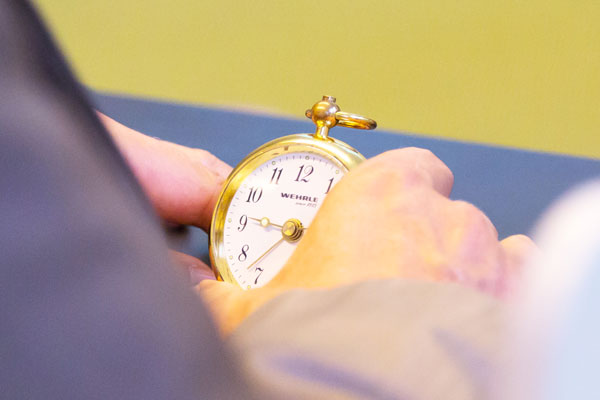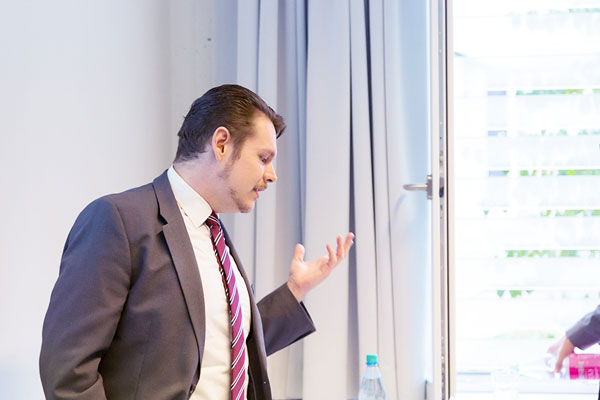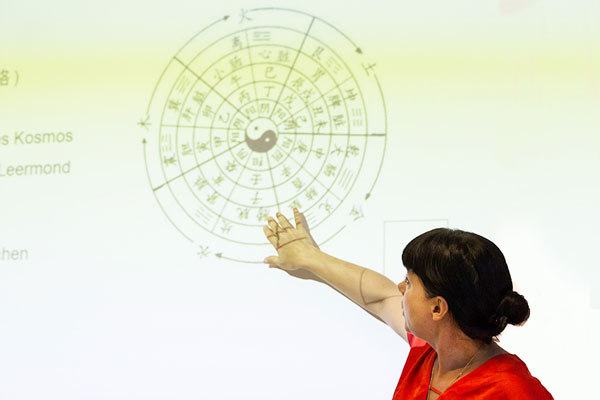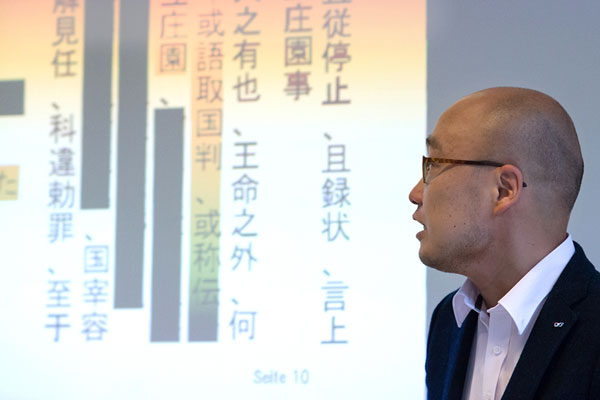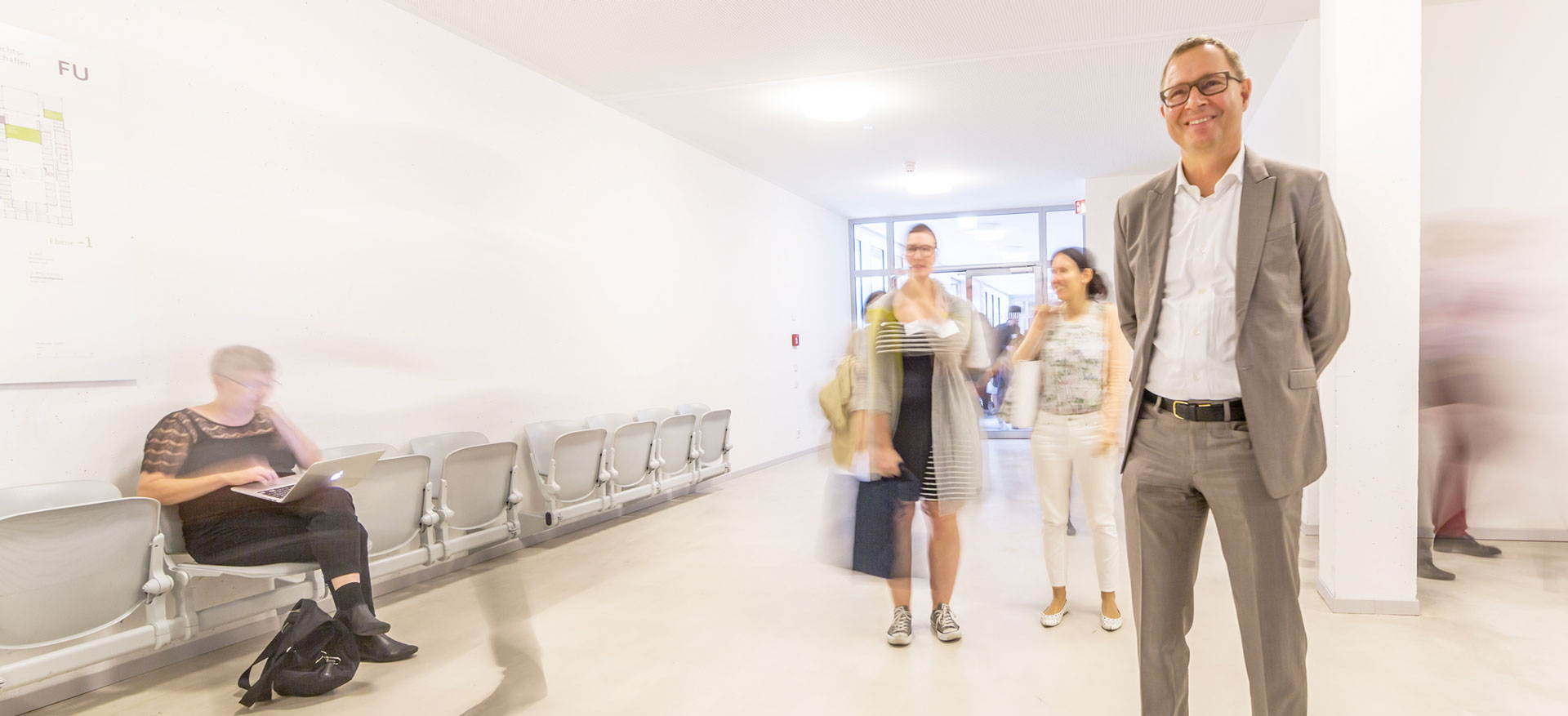
The silent power of time
How the Japanologist Raji C. Steineck and his interdisciplinary team explore concepts of time in medieval Japan in a novel way and what we learn by this ERC project about our own perception of time.
«It’s a once-in-a-lifetime opportunity to participate in this project,» says Georg Blind while we are walking to the refectory. Georg is a Japanologist, holds a PhD degree in Economy and had some years’ experience as a consultant at McKinsey before he went back to academia. Two years ago, Raji Steineck, Professor of Japanese Philology at the University of Zurich, asked Georg to join his international team as senior researcher to work on the ERC project called «Time in Medieval Japan». Georg immediately agreed.
It’s a cloudy day in late August on the campus of the Freie Universität at Berlin Dahlem. The sessions of the 17th German-speaking Japanese Studies Conference were halted for a noon break and I join Raji Steineck and members of his research team for lunch. They just presented their project for the first time to a broader audience on a panel session this morning and received great attention among the 350 participants of the conference. Now, sitting at a large table in the refectory, I ask Georg as well as the other team members Kohei Kataoka, Etienne Staehelin and Daniela Tan, what it is that fascinates them about working on this EU-financed project. They all agree: «It is about being part of an interdisciplinary international team pursuing a common aim, applying a common methodology and having the means and the funds to stick to research on a most exciting topic for five years.» As a matter of fact, this kind of project is quite exceptional within the humanities.
«Time is a fundamental condition
of our human existence,
which goes far beyond Japanology.»
Traditionally, scholars in this field tend to work individually, pursuing their own ideas and projects. «This has its benefits, certainly, but there are limitations as well,» Raji Steineck says while we choose our meal at the buffet. «For certain research subjects, you just need a larger group of different people with different kinds of expertise and training who are willing to cooperate, develop a common framework and then work with that framework for a certain period of time to solve a problem.»
Time in medieval Japan and beyond
«Time in medieval Japan» is such a research subject for Raji Steineck. «It is something that I have been wanting to do for quite some time. So, this ERC Grant offered me the great chance to create a research group that has a common motivation and is exclusively there to systematically explore this subject,» he explains. Hence, since September 2017, eight scholars – three PhD students, two postdocs, three senior researchers and Raji Steineck himself – have been exploring perceptions and concepts of time in the Japanese society between the 10th and the 15th century, covering the fields of literature, economy, religion, philosophy, history and medical history.
At a first glance, the topic sounds pretty exotic. So, what makes this project so exciting for scholars and also relevant to a broader audience? «Time is a fundamental condition of our human existence, which goes far beyond Japanology,» Raji Steineck replies. «Time is a coordinate system that we all use to order events and experiences in our life and world. In our modern Western society, we tend to look mainly at the quantitative aspect of time. Measurement and calculating are dominant in our time perception. But time has many other properties beyond clocks and timetables. By exploring time concepts in a premodern non-Western society like medieval Japan, we try to gain a better understanding of human strategies to deal with time and of the way time concepts are linked to social organisation. Finally, we hope to get a more realistic image of ourselves and our handling of time.»
Zen, aristocratic court, market – case studies in time perception
Raji Steineck and his team focus on three different spheres of the highly differentiated medieval Japanese society: the Zen monasteries, the female court aristocracy and the market. As a fourth connecting subject they explore the description of the female menstrual cycle under the aspect of body time addressed in medical documents but also in religion and literature texts of medieval Japan. Research work for Raji Steineck and his team means to search through hundreds of medieval documents and books for time expressions, to analyse usage, rules and properties related to time and to discover the underlying concept of time. Measuring and calculating time as well as exact dating play an important role in many documents, mainly when the texts are about contracts, economic topics and historiography. But many documents talk about different properties of time like moods, transience, beauty or eternity. Time of different properties produces different logics and rules, which might lead to conflicts between social groups following their prevalent concept of time. Therefore, in a highly differentiated society, time has to be negotiated to specify which kind of time on what occasion is valid for which section of society. As an example for how conflicting time concepts were managed in medieval Japan, Raji Steineck quotes a text from the famous Zen scholar Dogen, who was the abbot of a monastery in Kyoto during the 13th century. The monks of the monastic community live from donations they receive from individuals and aristocratic patrons. In a document, Dogen advises the monk in charge of the monastery’s household on how to deal with a donation made for the purpose of buying rice for a community lunch.
«Time has many other properties
beyond clocks and timetables.»
He should go to the market and buy exactly the quantity of rice at the day’s price that is needed for the meal. If there is any money left, it has to be returned to the donor. The monk in charge is not allowed to keep it in order to spend it later or buy more rice and lend it to others for interest. What seems strange at first is a clear instruction on how to behave as a Buddhist monk when you are confronted with two different concepts of time. «As monks in a monastery, they perform the life of Buddha and the patriarchs and as such they operate on a different logic, a logic of eternity. Therefore, from his religious perspective, the abbot wants to make sure that the economic perspective, where you take care of your personal small life and the survival of your community, does not interfere with that larger perspective of eternity. Hence, you have to be very careful how you interpret this kind of conflicts. You need to see them in the logic of symbolic forms,» Raji Steineck explains. This leads us to the methodology he and his team apply on the documents and on their entire research.
A common analysing tool
To detect how time is expressed, the team reads selected medieval documents very carefully and systematically. Additionally, the researchers also screen digitised texts from medieval times with computers to retrieve words referring to time. In such a text on Zen Buddhism, for example, they are assessing where and in which context the word «year» appears. «We then analyse whether time is expressed primarily in quantitative or in qualitative terms, whether it’s mainly in a context of regulating time or contemplating time or in terms of attitude towards time.
«This kind of project
is quite exceptional
within the humanities.»
We are trying to develop a fine grade of analysis of the way time is expressed in the various sources. From that ground we build up hypotheses about the way time was perceived, evaluated and regulated in different fields of society,» Steineck explains their working method. To analyse and distinguish the several «sorts of time» mentioned in the documents the team applies a common analytical tool based on three categories of time perception: Chronography is focussing on the way time is expressed in written texts. Chronometry, covering the quantitative aspects of time such as hours or dates, is just one part of Chronography. There are other ways of time perceptions as well. An evening can be expressed either by an exact number on the clock or by describing a sunset or a night of a full moon. Chronopolicy is about the regulation of time use. Mighty social groups like political elites intend to impose their time concept and their rules of time use on the entire society; hence, time becomes an instrument of power. In order to prove their legitimacy, elites create historiographies and genealogies to show that they are rooted in a long tradition. Chrononoetics finally deals with the concepts of time and the larger forms in which they are expressed (poems, religious texts, etc.).
The overall layout – theory of symbolic forms
Having categorised the data, the team then starts formulating and testing hypotheses about time, based on the theory of symbolic forms. It basically says that in a society there are different «fields» such as religion, art, law, economics, etc., with different values that guide people in their behavior*. Raji Steineck emphasises the significance of the theory of symbolic forms for the project as a whole: «This theory is very important as an overall layout for our project because it states that you can best understand culture when you look at the various domains of validity that operate in a society and orchestrate what people orient themselves towards.»
There has been an academic dispute among scholars for quite some time about time perception and modernity. Some say that measurement and calculation of time primarily came up with the industrialisation in the West and stands for modernity. In premodern societies like medieval Japan people did not care about the quantitative aspects of time, they simply lived with natural rhythms of agriculture. Raji Steineck and his team want to show that medieval Japan in many aspects had a much more complex relation to time, far beyond days and seasons. They intend to prove that Japanese people in this era were very much aware of time, applying several concepts including quantification and dealt with similar sophisticated time-related topics as we do today. So, the ERC project also contributes to settle an academic dispute. In the meantime, we finished lunch and enjoy a coffee. Before Raji Steineck and his research fellows have to leave to join the afternoon sessions of the conference, I would like to know what motivates him most to work on this project. With a smile he answers: «We have a lot of theories which are established by Western scholars looking at Western sources, assuming this is a kind of universal model. I don’t necessarily challenge the universality of these models, but it is important to test them. That is what good scientists are doing in the end. So, we try putting things to the reality test and, in my case, evidence is provided by Japanese sources.»
* The theory of symbolic forms was developed by the German philosopher Ernst Cassirer (1874 – 1945). He published his Philosophie der symbolischen Formen in three volumes between 1923 and 1929. The research concept of the ERC project is based on a further development of Cassirer’s theory by Raji C.Steineck in his book Kritik der symbolischen Formen I: Symbolische Form und Funktion, Stuttgart-Bad Cannstatt: Frommann-Holzboog, 2014 (Philosophie Interkulturell, 3).
Time in medieval Japan
The project explores time in medieval Japan taking a new approach to historical articulation of concepts of time, based on the theory of symbolic forms. It will examine symbolic representations and social regulations of time in a civilisation that is often juxtaposed to contemporary, globalised modernity.
Aim: To disclose the specific cultural practices operative in the respective ways of negotiating and to achieve a more comprehensive, detailed account of human strategies in dealing with time. The results will be compared to the history of time in the Western world and integrated into a theory of symbolic forms of time.
Research team: Prof. Raji Steineck (project leader), PD Dr. Simone Müller, Vroni Ammann, Dr. Georg D. Blind, Alexandra Ciociaro, Dr. Kohei Kataoka, Etienne Staehelin, Dr. Daniela Tan.
Interview with Raji C. Steineck
Raji C. Steineck
Raji C. Steineck has been Professor of Japanese Philology at the University of Zurich since 2008. He studied Japanology, Philosophy and Musicology, obtaining a Master degree in Japanese studies in 1993 and a PhD in Philosophy in 1999 at the University of Bonn, Germany. In 2006, he received the venia legendi in Japanology from the same university. During research for his PhD and later on as a postdoc, he spent a total of 28 months at Kyoto University, Japan. Between 2002 and 2006, he was back at the University of Bonn, working as a research fellow in the group «Bioethical Conflicts in Japan». During this period, he published a number of articles on topics such as the debates on brain death and human embryo research in Japan and prepared a monograph on notions of the human body in Japanese bioethical debates. In addition, he taught in the departments of Japanese studies and philosophy and was invited as a teaching fellow to Adam Mickiewicz University in Poznań, Poland, in 2004. From 2007 to early 2008, he was Professor of Japanese Intellectual History at the German Goethe University Frankfurt, before taking office as Professor of Japanese Philology in Zurich. In 2010, he became Director of the Institute of East Asian Studies at the University of Zurich and, upon formation of the Institute of Asian and Oriental Studies in 2013, one of its founding directors. Raji C. Steineck is an active board member of the International Society for the Study of Time and its President since 2012. In 2017, he received an ERC Advanced Grant for the project «Time in medieval Japan».
ERC Advanced Grant
«TIMEJ: Time in medieval Japan»
Duration: 2017-2022
Financial contribution from H2020: 2,497,500 €




